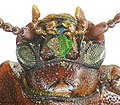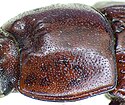Big rotten wood beetle
| Big rotten wood beetle | ||||||||||||
|---|---|---|---|---|---|---|---|---|---|---|---|---|

Big rotten wood beetle on pine bark |
||||||||||||
| Systematics | ||||||||||||
|
||||||||||||
| Scientific name | ||||||||||||
| Uloma culinaris | ||||||||||||
| ( Linnaeus , 1758) |
The big black beetle , also kitchen beetle , ( Uloma culinaris ) is a beetle from the family of the black beetle (Tenebrionidae). The genus Uloma is represented by five species in Europe, in Central Europe one can find, in addition to Uloma culinaris , the small rotten wood beetle ( Uloma rufa ). The beetle is listed in the Red List of Endangered Animals in Germany under category two (highly endangered), as is the case in North Rhine-Westphalia. In Baden-Württemberg it is classified as endangered.
The name "Großer Rotholz-Schwarzkäfer" is explained by the fact that it belongs to the black beetles named after their color, but the beetle is brown. The rotten wood beetle can be found in rotten wood and the addition “large” expresses that Uloma culinaris is slightly larger than the small rotten wood beetle Uloma rufa . The generic name Ulōma is from Old Gr . οὖλος "ōūlos" for "kraus" and ὦμος "ōmos" for "shoulder" derived. The name kitchen beetle comes from the species name culinaris ( Latin culina = kitchen). Although the kitchen is certainly not one of the typical habitats of this jungle relic, it is said to even appear in pantries of stored meat products. The name "Red Black Beetle", which is also in use, is misleading, as it is more related to Uloma rufa (Latin rufa = red).
Characteristics of the beetle
The elongated beetle with largely parallel sides reaches a length of ten to 11.5 millimeters. It is hairless, glossy dark brown and strongly arched in cross section.
The relatively small head (Fig. 1) is much wider than it is long. In the male, in contrast to Uloma rufa, the chin is flat with no upturned corners and, like the anterior chin, is hairy like felt (Fig. 2, marked in color on the right). The end link of the jaw palpation is somewhat ax-shaped. The short, eleven-link, cord-shaped antennae are thick and thicken further towards the outside. The antennae root is covered by a lobed lateral extension of the cheeks. A shallow groove runs across the forehead between the eyes and ends behind the eyes.
The dense and uniform dotted pronotum is much broader than the head. It is wider than it is long, the narrowest at the front, then it widens convexly at first, then hardly any more. It is clearly bordered on the side and on the slightly double-bayed base (Fig. 3 and 6). In the male, the pronotum is clearly indented behind the head, behind the impression there are two small bumps lying next to each other. (Fig. 1 and 3)
The wing covers are markedly longitudinally striped by strong rows of dots. The spaces between the dot stripes are flat and finely irregularly dotted (Fig. 4). The shoulder bumps are clearly developed.
The legs are strong. The outside of the front rails is strongly serrated towards the rounded, enlarged tip (Fig. 5 V). On the upper side there is a distal groove that enables the tarsus to be pushed back upwards. The outer edge of the middle rail is serrated more finely (Fig. 5 M), that of the rear rail is almost smooth (Fig. 5 H). The family belongs to the heteromeric family group, so the tarsi are four-membered on the hind leg, otherwise five-membered.
larva
The larvae of the genus Uloma (Fig. 8) are elongated. The pronotum is as long as the two following tergites combined. The legs are poorly developed. The last tergite of the abdomen is broadly rounded and ends in a small offset point.
biology
In contrast to Uloma rufa , the forest-dwelling beetle prefers the lower areas in Central Europe . In addition, it can be found not only on rotten coniferous wood, but also on rotten hardwood, occasionally on tree sponges and in heaps of sawdust. The species does not only develop in rotten wood, but also in the bark. Even neophytes as the red oak are accepted. Standing trunks and areas of living trees that are covered with fungus are populated a little more favorably than lying trunk wood or thick crown parts lying on the ground. The adults appear in Central Europe from April to August. They live in tree hollows and wood garbage, for example in the larval tunnels of the oak buck or the grain buck .
distribution
The distribution area of the species extends in Europe from Sweden and Norway in the north to Italy , Greece and Crete in the south. The beetle is absent in the west on the British Isles and the Iberian Peninsula , the eastern border of the range runs through the Baltic States , Poland , Slovakia , Hungary , Romania and Bulgaria . Outside Europe, the species can still be found in parts of Asia ( Persia , Siberia ).
literature
- Heinz joy , Karl Wilhelm Harde , Gustav Adolf Lohse (ed.): The beetles of Central Europe . tape 8 . Teredilia Heteromera Lamellicornia . Elsevier, Spektrum, Akademischer Verlag, Munich 1969, ISBN 3-8274-0682-X .
- Klaus Koch : The Beetles of Central Europe Ecology . 1st edition. tape 2 . Goecke & Evers, Krefeld 1989, ISBN 3-87263-040-7 .
- Edmund Reitter : Fauna Germanica, the beetles of the German Empire III. Volume, KGLutz 'publishing house, Stuttgart 1911
Individual evidence
- ^ A b Edmund Reitter : Fauna Germanica, the beetles of the German Empire III. Volume, KGLutz 'publishing house, Stuttgart 1911
- ↑ a b Uloma culinaris at Fauna Europaea. Retrieved October 24, 2012
- ↑ Uloma at Fauna Europaea. Retrieved October 21, 2012
- ↑ Red Lists of Bionetworx
- ↑ a b c Profile of ARGE SWD Koleopterologen ( Memento of the original from March 4, 2016 in the Internet Archive ) Info: The archive link was inserted automatically and has not yet been checked. Please check the original and archive link according to the instructions and then remove this notice.
- ↑ Sigmund Schenkling: Explanation of the scientific beetle names (genus)
- ↑ Herrman Nördlinger: The small enemies of agriculture: or treatise in field, garden ... Cotta'sche Buchhandlung Stuttgart 1869
- ↑ Klaus Koch : Die Käfer Mitteleuropas Ökologie . 1st edition. tape 2 . Goecke & Evers, Krefeld 1989, ISBN 3-87263-040-7 .
- ^ Info sheet from TU Berlin
- ↑ Jörn Buse, Petr Zabransky, Thorsten Assmann: The xylobiontic beetle fauna of old oaks colonized by the endangered longhorn beetle Cerambyx cerdo Linnaeus, 1758 (Coleoptera: Cerambycidae) Mitt. Dtsch. General Applied Ent. 16 Giessen 2008










